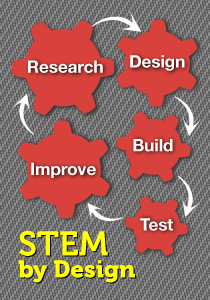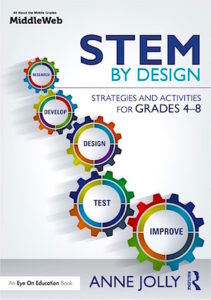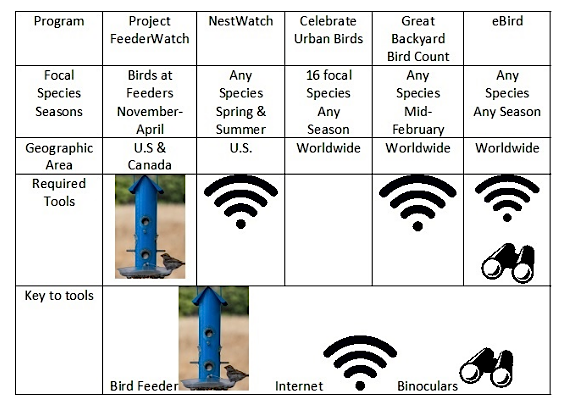Build STEM Skills Now: Try Citizen Science!
A MiddleWeb Blog
 This school year is making the inevitable fourth quarter turn and taking aim at the finish line. Count on it – your students’ energy and concentration are about to start slipping. Lackluster events such as test prep predictably crowd in and interfere with lesson continuity. How can you give your STEM lessons a boost and snag your students’ interest again?
This school year is making the inevitable fourth quarter turn and taking aim at the finish line. Count on it – your students’ energy and concentration are about to start slipping. Lackluster events such as test prep predictably crowd in and interfere with lesson continuity. How can you give your STEM lessons a boost and snag your students’ interest again?
Here’s an idea: how about involving your kids in citizen science? Now, I’m a stickler for doing STEM “right.” But I like citizen science as a way of polishing STEM skills even though kids aren’t driving a STEM project to fruition.
Citizen science sharpens STEM proficiencies like observing, questioning, planning, analyzing, and communicating. I’ve used this approach as a way of getting my students’ brains wrapped around carefully monitoring things going on in the real world – then reporting their observations to scientists and engineers. Citizen science gives kids a real role to play in solving a meaningful community – or even national – problem.
Remind me – What is citizen science?
Citizen Science Central defines citizen science as Projects in which volunteers partner with scientists to answer real-world questions. Citizen science connects people (in this case, students) with real scientists to solve local needs in a community, or the greater needs of a state or province or the nation. Sometimes scientists need more data than they can collect on their own. Citizens (including students) can help trained scientists gather data from all over the world – from hummingbirds to microplastics pollution.
From Cornell’s Lab of Ornithology
If your kids are citizen scientists, they make observations, collect data, and submit these to scientists who need this information. That’s real stuff! If you go this route, watch out for reenergized students. They just might get a real boost from directly contributing to authentic investigations in fun and meaningful ways.
How do you launch a citizen science initiative?
Decide on a citizen science project. You may be familiar with the GLOBE program – my favorite starting place for doable citizen science activities. NASA scientists are gathering widespread information about local climates and weather patterns.
From NASA GLOBE Observer
My students had good success documenting needed information about clouds, surface temperature, precipitation, and soil moisture in our area and sharing it with NASA. Kids can even get free equipment for collecting the needed data. Here’s a great kick-off idea – your kids can become GLOBE observers and provide sky observation information and photographs of clouds to NASA using a free, downloadable app.
Many citizen science efforts connect to the interests of students. For example, let’s say your students are interested in birds. Cornell’s Lab of Ornithology welcomes them! They want your students to collect data about your local birds and send the information to scientists who study bird populations and conservation.
But, wait! you say. My students don’t know enough about birds to do that. No problem! Look at the grade-level resources Cornell provides – copious lessons, curriculum units, and supplemental materials – all free downloads! (These lessons are correlated with the Common Core and the Next Generation Science Standards.)
Perhaps birds aren’t in your students’ bailiwick. You can locate lots of projects online. SciStarter is a popular citizen science project site. I started out by simply typing my location under by keyword in the Find a Project section on the opening screen. I was rewarded with information about projects going on right in my area. And SciStarter for Educators lists current projects for student involvement in teacher-friendly fashion. The SciStarter Project Finder is the perfect starting place for finding hundreds of projects suitable for all ages. Many include teaching materials.
CoCoRaHS, the Community Collaborative Rain, Hail, and Snow Network, is a grassroots volunteer network of folks who observe and map weather data from across the United States and Canada. The site provides lesson plans with plenty of background material for students. In addition, mentors may be available to help schools in your areas.
From SciStarters.org
NASA and NOAA also have projects that join forces with citizen scientists. And that’s just the tip of the citizen science projects iceberg. See this Wikipedia list if you don’t believe me.
Perhaps your kids want to help local scientists and engineers by collecting and reporting data that helps in decision-making. You (with the help of your students) might do a local search for suitable projects. This National Geographic link suggests community projects in which kids can be involved. Note: If you’re teaching STEM, stick to those projects that have STEM learning connections. For example, see Investigate Your Water, Improve Your Neighborhood, Pick Up Trash, Recycle, Clean-Up, etc.
The advice to “keep STEM in mind” goes for all these ideas. Whatever citizen science projects your students are tackling, be sure to make clear, intentional connections to STEM for them. The citizen science projects may not be complete STEM projects, but they help students advance their STEM-related skills as they pursue future studies.
Do it yourself
Maybe you and your kids want to design your own citizen science project and recruit others to help gather and send data to you. Online toolkits can help you with that – like this one from Citizen Science Central. Take a look at Citizen Science Toolkit for detailed suggestions and also Choose Your Own Citizen Science Project. Not what you’re looking for? Just type Design your own citizen science project into a search engine and wait as your screen fills with a plethora of possibilities.
Build awareness and buy-in on the upcoming Citizen Science Day
Once your students understand what citizen science is, ask them to help you celebrate Citizen Science Day on April 13th, 2019. This annual event celebrates and promotes citizen science and inspiring projects. It’s not hard. This planning site offers great teacher ideas, information, and free downloadable resources such as logos, videos, and press releases.
From Citizen Science Day resources
Real science for real STEM skills
In conclusion, citizen science projects are great learning environments for your STEM scholars. When kids know they are part of a real science mission, and they work with real scientists, they’re pumped. They’re far more motivated to try for success because they know that their observations and reporting are making a difference.
Here’s the bottom line: if you want to spend the last quarter of the school year winding your students up instead of letting them run down, you’ll have plenty of help from the citizen science community.
As an FYI – if you (the adult in the room) are personally interested in being a citizen scientist and taking an active role in scientific discovery, check out this list of over 400 projects that are ongoing nationwide: Citizen Science Catalog.
___________________________________________





































